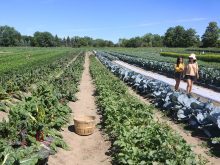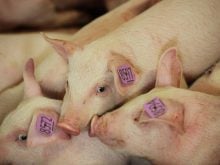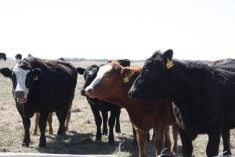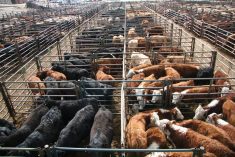RIMBEY, Alta. – Determination and devotion among small groups of Canadian farmers have preserved rare breeds of livestock and poultry.
At Judy Fitzsimons’s farm in central Alberta, small groups of unusual sheep and cattle graze the hilly pastures she owns with her husband, Len, and son, Dan.
“We’re always looking for farms from Grandma’s time in the same family that kept the breed going so you are getting the original strain. That is hard to find,” Fitzsimons said.
She is a founding member of the Alberta chapter of Rare Breeds Canada, which was established to save rare and ancient breeds of animals from extinction.
Read Also

Canada told trade crisis solutions in its hands
Canadians and Canadian exporters need to accept that the old rules of trade are over, and open access to the U.S. market may also be over, says the chief financial correspondent for CTV News.
The non-profit group based at Trent University in Peterborough, Ont., looks for low numbers of Canadian heritage breeds commonly raised on farms between 1750 and 1959. They should be historically significant to commercial agriculture in Canada.
Members are also concerned about saving breeds originating in Canada. A heritage breed is defined as having been in Canada for at least 50 years and used as a viable commercial breed.
Many breeds have been pushed aside by modern genetics.
Fitzsimons started with Highland cattle, a red-brown shaggy breed with wide curving horns. Healthy and hardy animals, she wanted them to graze her rough pastures full of steep hills and brush.
“The Highlands will survive where other things won’t,” she said.
Interest is growing in this hardy Scottish breed and it has moved to the watch list from the endangered list. However, like her other breed, the Irish Kerry, these animals are smaller and reach maturity later than most modern breeds.
Fitzsimons also maintains four breeds of sheep: Soay, Shropshire, Jacob Spotted and Cotswold. She has them sheared each year and displays the wool and spun products when travelling with her animals to local fairs.
Soay sheep are an ancient horned breed with fine legs and deer-like faces. They come from the northwestern coast of England, where they were left on their own to develop without crossbreeding or other human interference.
The Jacob sheep have been delisted as a rare breed. Farmers have produced enough to form their own association to promote this ancient sheep that grows as many as four long, curving horns.
At one time 121,000 Shropshire sheep were registered with Canadian Livestock Breeds, but that had fallen to 57 by 2000.
“They are a neat breed but other breeds took their place and they went down in numbers,” Fitzsimons said of the short, heavyset breed that produces soft wool.
“I am the only who has them in Alberta.”
In 2000, 43 Cotswold sheep were registered. Cotswold was a popular breed at the turn of the 20th century. The animals have long wool once valued for making carpets and other heavy-wear items.
“When synthetics (yarns) came about, there was no need for the Cotswold. A lot of people didn’t want the long fibres because of the heavy shearing,” she said.
In addition to her four-legged breeds, Fitzsimons is boarding a variety of chickens for a friend.
Chickens have changed considerably from the old breeds. Today they are bred and raised for productivity and early maturity. The flock at her farm is a multicoloured group that includes Black Leghorn, Rhode Island Red, Plymouth Rock, Gold Duff Orkington and Light Sussex.
Few pigs are registered as rare breeds.
To add to her collection, Fitzsimons hopes to obtain Newfoundland ponies. They descended from a variety of horses imported to Newfoundland to work in coal mines. When they were no longer needed to pull carts, they interbred and were hunted down for dog meat.
Besides finding these breeds, members are always looking for homes for the animals. They prefer to place small groups on a number of farms. If the entire breed lived on one farm, they could all be lost in an accident or disease outbreak.
People with small farms are often interested in keeping some of these breeds. Spinners are looking for old sheep breeds because the wool is soft with a good crimp.
Last year was difficult for central Alberta breeders when drought dried up pastures and water supplies. Many animals were sold to the United States where interest in old breeds is enjoying resurgence.
“We sold just about everything that we could to cut down the numbers,” Fitzsimons said.
This year pastures are in better shape and breeders are looking for healthy stock to rebuild numbers.

















